All Exams >
Grade 6 >
Mathematics for Grade 6 >
All Questions
All questions of Common Fractions (Term 4) for Grade 6 Exam
How is the fractional number for "3 out of 7 of the fruits are apples" written?- a)3/7
- b)7/3
- c)4/7
- d)4/3
Correct answer is option 'A'. Can you explain this answer?
How is the fractional number for "3 out of 7 of the fruits are apples" written?
a)
3/7
b)
7/3
c)
4/7
d)
4/3
|
|
Himangshu Das answered |
3 out of 7 = 3/7 is the correct answer. Therefore option A is the correct answer...
In semiconductors, at the room temperature- a)valence band is completely filled
- b)conduction band is completely empty
- c)valance band is partially empty and conduction band is partially filled
- d)valence band is completely filled and conduction band is partially filled
Correct answer is option 'C'. Can you explain this answer?
In semiconductors, at the room temperature
a)
valence band is completely filled
b)
conduction band is completely empty
c)
valance band is partially empty and conduction band is partially filled
d)
valence band is completely filled and conduction band is partially filled
|
|
Disha Khanna answered |
Explanation:
Semiconductors are materials that have a conductivity between conductors (metals) and insulators (non-metals). The conductivity of a semiconductor can be controlled by adding impurities or doping. At the room temperature, the following conditions hold true for semiconductors:
Valence Band:
- The valence band is the highest energy band that is completely filled with electrons.
- The valence band consists of the valence electrons that are tightly bound to the atoms.
- At room temperature, the valence band is partially filled with electrons, but it is not completely filled.
Conduction Band:
- The conduction band is the lowest energy band that is partially filled with electrons.
- The conduction band consists of the free electrons that are not bound to any particular atom and can move freely through the material.
- At room temperature, the conduction band is partially filled with electrons, but it is not completely empty.
Energy Gap:
- The energy gap or band gap is the energy difference between the valence band and the conduction band.
- In insulators, the energy gap is very large, and no electrons can move from the valence band to the conduction band.
- In conductors, the energy gap is zero, and the valence and conduction bands overlap.
- In semiconductors, the energy gap is small, and electrons can move from the valence band to the conduction band by absorbing energy.
Conclusion:
At room temperature, semiconductors have a partially filled valence band and a partially filled conduction band. This allows them to conduct electricity, but the conductivity can be controlled by adding impurities or doping.
Semiconductors are materials that have a conductivity between conductors (metals) and insulators (non-metals). The conductivity of a semiconductor can be controlled by adding impurities or doping. At the room temperature, the following conditions hold true for semiconductors:
Valence Band:
- The valence band is the highest energy band that is completely filled with electrons.
- The valence band consists of the valence electrons that are tightly bound to the atoms.
- At room temperature, the valence band is partially filled with electrons, but it is not completely filled.
Conduction Band:
- The conduction band is the lowest energy band that is partially filled with electrons.
- The conduction band consists of the free electrons that are not bound to any particular atom and can move freely through the material.
- At room temperature, the conduction band is partially filled with electrons, but it is not completely empty.
Energy Gap:
- The energy gap or band gap is the energy difference between the valence band and the conduction band.
- In insulators, the energy gap is very large, and no electrons can move from the valence band to the conduction band.
- In conductors, the energy gap is zero, and the valence and conduction bands overlap.
- In semiconductors, the energy gap is small, and electrons can move from the valence band to the conduction band by absorbing energy.
Conclusion:
At room temperature, semiconductors have a partially filled valence band and a partially filled conduction band. This allows them to conduct electricity, but the conductivity can be controlled by adding impurities or doping.
What is the mixed fraction form of 41/12
- a)

- b)

- c)

- d)

Correct answer is option 'C'. Can you explain this answer?
What is the mixed fraction form of 41/12
a)

b)

c)

d)


|
Naina Iyer answered |
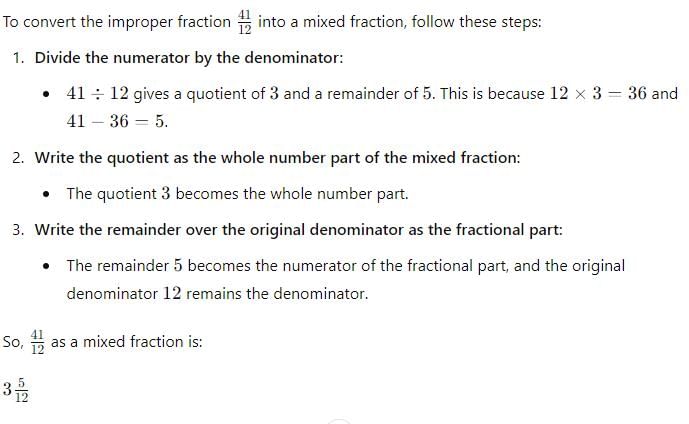
Explanation:
- Quotient: The integer part of the division, which is 333, represents how many whole parts of the denominator fit into the numerator.
- Remainder: The leftover part after dividing, which is 555, represents the part of the fraction that does not fit into a whole number.
- Denominator: The original denominator 121212 remains unchanged for the fractional part.

What is the fractional form of five eighteenths?- a)15/18
- b)18/5
- c)5.18
- d)5/18
Correct answer is option 'D'. Can you explain this answer?
What is the fractional form of five eighteenths?
a)
15/18
b)
18/5
c)
5.18
d)
5/18

|
Raj Mukherjee answered |
The fractional form of five eighteenths
= 5/18
What type of fraction is the sum 3/4 + 2/4?- a)Proper fraction
- b)Improper fraction
- c)Mixed fraction
- d)Unit fraction
Correct answer is option 'B'. Can you explain this answer?
What type of fraction is the sum 3/4 + 2/4?
a)
Proper fraction
b)
Improper fraction
c)
Mixed fraction
d)
Unit fraction

|
Yashvi Choudhary answered |
3/4 + 2/4 = 3+2/4 = 5/4 is an improper fraction. Since, the numerator is greater than the denominator.
Shabana has to stitch 35 dresses. So, ar she has stitched 21 dresses. What fraction of dresses has she stitched?- a)7/9
- b)3/5
- c)6/5
- d)3/7
Correct answer is option 'B'. Can you explain this answer?
Shabana has to stitch 35 dresses. So, ar she has stitched 21 dresses. What fraction of dresses has she stitched?
a)
7/9
b)
3/5
c)
6/5
d)
3/7

|
EduRev Class 6 answered |
Shabana has stitched 21 dresses out of a total of 35 dresses. The fraction of dresses she has stitched is 21/35.
To simplify, divide both the numerator (21) and denominator (35) by their HCF, which is 7:

So, the correct fraction of dresses she has stitched is 3/5.

So, the correct fraction of dresses she has stitched is 3/5.
Give an example for a proper fraction.- a)28/13
- b)11/23
- c)16/9
- d)14/3
Correct answer is option 'B'. Can you explain this answer?
Give an example for a proper fraction.
a)
28/13
b)
11/23
c)
16/9
d)
14/3

|
Subham Rane answered |
In a proper fraction, the numerator is less than the denominator.
By how much is 19/20 greater than 2/20?- a)21/20
- b)21/40
- c)17/20
- d)17/40
Correct answer is option 'C'. Can you explain this answer?
By how much is 19/20 greater than 2/20?
a)
21/20
b)
21/40
c)
17/20
d)
17/40

|
Shounak Joshi answered |
19/20 - 2/20 = 19 - 2/20 = 17/20
Two fractions are equivalent if their cross multiplications are- a)0.
- b)1.
- c)equal.
- d)not equal.
Correct answer is option 'C'. Can you explain this answer?
Two fractions are equivalent if their cross multiplications are
a)
0.
b)
1.
c)
equal.
d)
not equal.

|
Harshitha Mukherjee answered |
Two fractions are equivalent if they have the same value. The numbers may be different, but the overall value is the same. For example, 1/2 and 2/4 are equivalent fractions because they both represent one-half of something. To determine if two fractions are equivalent, cross multiply. To cross multiply, you multiple the numerator of the first fraction by the denominator of the second. Then you multiply the denominator of the first fraction by the numerator of the second. If the two numbers are equal, the fractions are equivalent. In this example 1 X 4 = 4 and 2 X 2 = 4. The fractions are therefore equivalent.
Which of the following fractions is the largest?- a)29/30
- b)29/23
- c)29/27
- d)29/25
Correct answer is option 'B'. Can you explain this answer?
Which of the following fractions is the largest?
a)
29/30
b)
29/23
c)
29/27
d)
29/25

|
Ameya Choudhury answered |
All fractions have the same numerator. So, the fraction having the smallest denominator is the largest.
∴ 29/23 is the required largest fraction.
Raju scored 9 marks in maths test. If the maximum marks of the test is 25, how is Raju's score represented as a fraction?- a)1/25
- b)16/25
- c)9/25
- d)25/25
Correct answer is option 'C'. Can you explain this answer?
Raju scored 9 marks in maths test. If the maximum marks of the test is 25, how is Raju's score represented as a fraction?
a)
1/25
b)
16/25
c)
9/25
d)
25/25
|
|
Ananya Das answered |
To represent Raju's score as a fraction, we need to express the number of marks he scored out of the maximum marks of the test. Let's break down the problem step by step:
1. Raju's score: Raju scored 9 marks in the maths test.
2. Maximum marks: The maximum marks of the test is given as 25.
3. Constructing the fraction: To represent Raju's score as a fraction, we need to express the number of marks he scored out of the maximum marks. Therefore, the numerator of the fraction will be Raju's score, which is 9. The denominator of the fraction will be the maximum marks, which is 25.
4. Simplifying the fraction: To simplify the fraction, we need to find the greatest common divisor (GCD) of the numerator and denominator. In this case, the GCD of 9 and 25 is 1, as there are no common factors other than 1. So we cannot simplify the fraction any further.
5. Final representation: The fraction representing Raju's score is 9/25. This means that Raju scored 9 out of 25 marks in the maths test.
Therefore, the correct answer is option 'C' - 9/25.
1. Raju's score: Raju scored 9 marks in the maths test.
2. Maximum marks: The maximum marks of the test is given as 25.
3. Constructing the fraction: To represent Raju's score as a fraction, we need to express the number of marks he scored out of the maximum marks. Therefore, the numerator of the fraction will be Raju's score, which is 9. The denominator of the fraction will be the maximum marks, which is 25.
4. Simplifying the fraction: To simplify the fraction, we need to find the greatest common divisor (GCD) of the numerator and denominator. In this case, the GCD of 9 and 25 is 1, as there are no common factors other than 1. So we cannot simplify the fraction any further.
5. Final representation: The fraction representing Raju's score is 9/25. This means that Raju scored 9 out of 25 marks in the maths test.
Therefore, the correct answer is option 'C' - 9/25.
Which of the following is not a proper fraction?- a)3/4
- b)7/8
- c)6/11
- d)8/5
Correct answer is option 'D'. Can you explain this answer?
Which of the following is not a proper fraction?
a)
3/4
b)
7/8
c)
6/11
d)
8/5

|
Siva Prasad answered |
The denominator is less than numerator
If 5/6 is equivalent to X/24, then what is the value of X?- a)15
- b)20
- c)25
- d)30
Correct answer is option 'B'. Can you explain this answer?
If 5/6 is equivalent to X/24, then what is the value of X?
a)
15
b)
20
c)
25
d)
30
|
|
Shubham Gupta answered |
Understanding the Problem
To find the value of X in the equation 5/6 = X/24, we need to set up a proportion. This means that the two ratios on either side of the equation are equivalent.
Setting Up the Equation
1. Write the equation:
5/6 = X/24
2. Use cross-multiplication to solve for X:
5 * 24 = 6 * X
Calculating the Values
1. Multiply 5 by 24:
5 * 24 = 120
2. Now the equation looks like this:
120 = 6X
3. To isolate X, divide both sides by 6:
X = 120 / 6
Final Calculation
1. Perform the division:
120 ÷ 6 = 20
2. Thus, the value of X is 20.
Conclusion
The correct answer is option 'B'. To summarize:
- Cross-multiply to set up the equation.
- Calculate 5 times 24 to get 120.
- Divide 120 by 6 to find X.
Hence, X = 20.
To find the value of X in the equation 5/6 = X/24, we need to set up a proportion. This means that the two ratios on either side of the equation are equivalent.
Setting Up the Equation
1. Write the equation:
5/6 = X/24
2. Use cross-multiplication to solve for X:
5 * 24 = 6 * X
Calculating the Values
1. Multiply 5 by 24:
5 * 24 = 120
2. Now the equation looks like this:
120 = 6X
3. To isolate X, divide both sides by 6:
X = 120 / 6
Final Calculation
1. Perform the division:
120 ÷ 6 = 20
2. Thus, the value of X is 20.
Conclusion
The correct answer is option 'B'. To summarize:
- Cross-multiply to set up the equation.
- Calculate 5 times 24 to get 120.
- Divide 120 by 6 to find X.
Hence, X = 20.
Which of the following is a proper fraction?- a)4/5
- b)6/5
- c)

- d)

Correct answer is option 'A'. Can you explain this answer?
Which of the following is a proper fraction?
a)
4/5
b)
6/5
c)

d)

|
|
Subset Academy answered |
A proper fraction is a fraction where the numerator (the top number) is smaller than the denominator (the bottom number).
4/5 is a proper fraction because 4 is less than 5.
So, Option A: 45\frac{4}{5}54 is the correct answer.
4/5 is a proper fraction because 4 is less than 5.
So, Option A: 45\frac{4}{5}54 is the correct answer.
What is the equivalent fraction of 5/12 having denominator 84?- a)25/84
- b)35/84
- c)30/84
- d)40/84
Correct answer is option 'B'. Can you explain this answer?
What is the equivalent fraction of 5/12 having denominator 84?
a)
25/84
b)
35/84
c)
30/84
d)
40/84
|
|
Preethi Dasgupta answered |
Solution:
To find the equivalent fraction of 5/12 with a denominator of 84, we need to multiply both the numerator and the denominator by the same number so that the denominator becomes 84.
Step 1: Find the common factor between the current denominator (12) and the desired denominator (84).
- The common factor between 12 and 84 is 12.
Step 2: Divide the desired denominator (84) by the common factor (12) to find the multiplier.
- 84 ÷ 12 = 7
Step 3: Multiply both the numerator and the denominator of the given fraction by the multiplier.
- Numerator: 5 × 7 = 35
- Denominator: 12 × 7 = 84
Therefore, the equivalent fraction of 5/12 with a denominator of 84 is 35/84.
Explanation:
- Fractions represent parts of a whole. They can be equivalent to each other if their values are the same. To find an equivalent fraction, we can multiply or divide the numerator and denominator by the same number.
- In this question, we are given the fraction 5/12 and asked to find an equivalent fraction with a denominator of 84.
- To achieve this, we need to find the multiplier that will make the current denominator (12) equal to the desired denominator (84).
- The common factor between 12 and 84 is 12. Dividing 84 by 12 gives us a multiplier of 7.
- By multiplying both the numerator and denominator of the given fraction by 7, we get the equivalent fraction 35/84.
- This means that 35 out of 84 parts is the same as 5 out of 12 parts.
- The correct answer is option 'B' - 35/84.
To find the equivalent fraction of 5/12 with a denominator of 84, we need to multiply both the numerator and the denominator by the same number so that the denominator becomes 84.
Step 1: Find the common factor between the current denominator (12) and the desired denominator (84).
- The common factor between 12 and 84 is 12.
Step 2: Divide the desired denominator (84) by the common factor (12) to find the multiplier.
- 84 ÷ 12 = 7
Step 3: Multiply both the numerator and the denominator of the given fraction by the multiplier.
- Numerator: 5 × 7 = 35
- Denominator: 12 × 7 = 84
Therefore, the equivalent fraction of 5/12 with a denominator of 84 is 35/84.
Explanation:
- Fractions represent parts of a whole. They can be equivalent to each other if their values are the same. To find an equivalent fraction, we can multiply or divide the numerator and denominator by the same number.
- In this question, we are given the fraction 5/12 and asked to find an equivalent fraction with a denominator of 84.
- To achieve this, we need to find the multiplier that will make the current denominator (12) equal to the desired denominator (84).
- The common factor between 12 and 84 is 12. Dividing 84 by 12 gives us a multiplier of 7.
- By multiplying both the numerator and denominator of the given fraction by 7, we get the equivalent fraction 35/84.
- This means that 35 out of 84 parts is the same as 5 out of 12 parts.
- The correct answer is option 'B' - 35/84.
What is the simplified form of the product 12/24 and 36/72- a)16/24
- b)3/5
- c)4
- d)1/4
Correct answer is option 'D'. Can you explain this answer?
What is the simplified form of the product 12/24 and 36/72
a)
16/24
b)
3/5
c)
4
d)
1/4

|
Isha Basak answered |
12/24 x 36/72 = 1/2 x 1/2 = 1/4
To reduce a rational number to its standard form, we divide its numerator and denominator by their- a)LCM
- b)HCF
- c)product
- d)multiple
Correct answer is option 'B'. Can you explain this answer?
To reduce a rational number to its standard form, we divide its numerator and denominator by their
a)
LCM
b)
HCF
c)
product
d)
multiple
|
|
Subset Academy answered |
To reduce a rational number to its standard form, we divide its numerator and denominator by their HCF (Highest Common Factor). This ensures the fraction is in its simplest form.
Which of the following is not in the lowest form?- a)7/5
- b)15/20
- c)13/33
- d)27/28
Correct answer is option 'B'. Can you explain this answer?
Which of the following is not in the lowest form?
a)
7/5
b)
15/20
c)
13/33
d)
27/28

|
Vp Classes answered |
To determine if a fraction is in its lowest form, we check if the numerator and denominator have any common factors other than 1.
- 15/20: The HCF of 15 and 20 is 5. So, 15/20 can be simplified to 3/4. Thus, it is not in its lowest form.
- 7/5, 13/33, and 27/28 are already in their lowest form because their numerators and denominators have no common factors other than 1.
What is the equivalent fraction of 56/70 with numerator 4?- a)4/15
- b)4/6
- c)4/5
- d)4/7
Correct answer is option 'C'. Can you explain this answer?
What is the equivalent fraction of 56/70 with numerator 4?
a)
4/15
b)
4/6
c)
4/5
d)
4/7
|
|
Maitri Bajaj answered |
To find the equivalent fraction of 56/70 with a numerator of 4, we need to divide both the numerator and the denominator by the same number to simplify the fraction.
Step 1: Find the greatest common divisor (GCD) of 56 and 70.
The GCD of 56 and 70 is 14.
Step 2: Divide both the numerator and the denominator by the GCD.
56 ÷ 14 = 4
70 ÷ 14 = 5
Therefore, the equivalent fraction of 56/70 with a numerator of 4 is 4/5.
Explanation:
- To find an equivalent fraction, we need to divide both the numerator and the denominator by the same number.
- The GCD is the largest number that divides both the numerator and the denominator without leaving a remainder.
- In this case, the GCD of 56 and 70 is 14.
- Dividing both the numerator and the denominator by 14 simplifies the fraction to 4/5.
- This means that 4/5 is an equivalent fraction to 56/70, with a numerator of 4.
- Option C, 4/5, is the correct answer.
Step 1: Find the greatest common divisor (GCD) of 56 and 70.
The GCD of 56 and 70 is 14.
Step 2: Divide both the numerator and the denominator by the GCD.
56 ÷ 14 = 4
70 ÷ 14 = 5
Therefore, the equivalent fraction of 56/70 with a numerator of 4 is 4/5.
Explanation:
- To find an equivalent fraction, we need to divide both the numerator and the denominator by the same number.
- The GCD is the largest number that divides both the numerator and the denominator without leaving a remainder.
- In this case, the GCD of 56 and 70 is 14.
- Dividing both the numerator and the denominator by 14 simplifies the fraction to 4/5.
- This means that 4/5 is an equivalent fraction to 56/70, with a numerator of 4.
- Option C, 4/5, is the correct answer.
What are the fractions with the same denominator called?- a)Unit fractions
- b)Unlike fractions
- c)Like fractions
- d)Improper fractions
Correct answer is option 'C'. Can you explain this answer?
What are the fractions with the same denominator called?
a)
Unit fractions
b)
Unlike fractions
c)
Like fractions
d)
Improper fractions

|
Shiksha Academy answered |
Fractions with the same denominator are called like fractions. For example:
- Examples of like fractions: 2/7, 5/7, 9/7
- Unlike fractions have different denominators: 1/4, 3/8, 5/6
- Unit fractions have numerator as 1: 1/2, 1/3, 1/4
- Improper fractions have numerator greater than or equal to the denominator: 7/5, 9/4
The mixed fraction  can be expressed as
can be expressed as - a)33/7
- b)39/7
- c)33/4
- d)39/4
Correct answer is option 'B'. Can you explain this answer?
The mixed fraction  can be expressed as
can be expressed as
 can be expressed as
can be expressed as a)
33/7
b)
39/7
c)
33/4
d)
39/4

|
Shiksha Academy answered |
To convert the mixed fraction  into an improper fraction:
into an improper fraction:
 into an improper fraction:
into an improper fraction:- Multiply the whole number (5) by the denominator (7): 5 × 7 = 35
- Add the numerator of the fraction (4) to the result: 35 + 4 = 39
- The improper fraction is 39/7.
Thus,  can be expressed as 39/7.
can be expressed as 39/7.
 can be expressed as 39/7.
can be expressed as 39/7.Which of the following is an improper fraction?- a)7/10
- b)7/9
- c)9/7
- d)none of these
Correct answer is option 'C'. Can you explain this answer?
Which of the following is an improper fraction?
a)
7/10
b)
7/9
c)
9/7
d)
none of these

|
Dr Manju Sen answered |
An improper fraction is one where the numerator is greater than or equal to the denominator.
- 7/10 and 7/9 are proper fractions because the numerator is smaller than the denominator.
- 9/7 is an improper fraction because the numerator (9) is greater than the denominator (7).

- a)6
- b)8
- c)7
- d)10
Correct answer is option 'B'. Can you explain this answer?

a)
6
b)
8
c)
7
d)
10

|
Ameya Choudhury answered |
Required expression

= 14 – [12 – {9 – (7 – 4)}]
= 14 – [12 – {9 – 3}]
= 14 – [12 – 6]
= 14 – 6 = 8

= 14 – [12 – {9 – (7 – 4)}]
= 14 – [12 – {9 – 3}]
= 14 – [12 – 6]
= 14 – 6 = 8

- a)9/35
- b)

- c)3/35
- d)

Correct answer is option 'B'. Can you explain this answer?

a)
9/35
b)

c)
3/35
d)


|
Harshad Shah answered |
Given expression
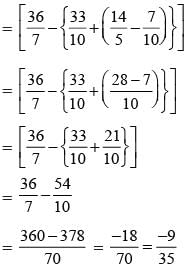

What of the following is not correct?- a)2/5 > 1/3
- b)1/4 < 2/3
- c)None of these
- d)1/7 > 3/5
Correct answer is option 'D'. Can you explain this answer?
What of the following is not correct?
a)
2/5 > 1/3
b)
1/4 < 2/3
c)
None of these
d)
1/7 > 3/5

|
Get Idea answered |
- Option A: 2/5 > 1/3: Convert to decimals: 2/5 = 0.4 and 1/3 ≈ 0.3333. Since 0.4 > 0.3333, this statement is true.
- Option B: 1/4 < 2/3: Convert to decimals: 1/4 = 0.25 and 2/3 ≈ 0.6667. Since 0.25 < 0.6667, this statement is true.
- Option D: 1/7 > 3/5: Convert to decimals: 1/7 ≈ 0.1429 and 3/5 = 0.6. Since 0.1429 < 0.6, this statement is false.
So, therefore Correct answer is (D).
2/5 = x/15
Find the value of X ?- a)2
- b)3
- c)5
- d)6
Correct answer is option 'D'. Can you explain this answer?
2/5 = x/15
Find the value of X ?
Find the value of X ?
a)
2
b)
3
c)
5
d)
6

|
EduRev Class 6 answered |
- Start with the equation: 2/5 = x/15.
- Cross-multiply to eliminate the fractions: 2 × 15 = 5 × x.
- Calculate the multiplication: 30 = 5x.
- Divide both sides by 5 to solve for x: x = 30/5.
- Therefore, x equals 6.
A fraction whose numerator is greater than its denominator is fraction.- a)an improper
- b)a proper
- c)a mixed
- d)None of these
Correct answer is option 'A'. Can you explain this answer?
A fraction whose numerator is greater than its denominator is fraction.
a)
an improper
b)
a proper
c)
a mixed
d)
None of these

|
Dr Manju Sen answered |
A fraction whose numerator is greater than its denominator is called an improper fraction. For example, 9/7 is an improper fraction because the numerator (9) is greater than the denominator (7).
The smallest of the fractions  is
is- a)1/2
- b)3/4
- c)5/6
- d)None of these
Correct answer is option 'A'. Can you explain this answer?
The smallest of the fractions  is
is
 is
isa)
1/2
b)
3/4
c)
5/6
d)
None of these

|
Nandita Choudhary answered |
Here, LCM of 4, 2, 6, 3 =12.
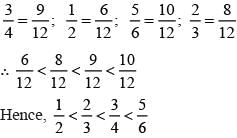

A fraction equivalent to 2/3 is - a)

- b)

- c)

- d)

Correct answer is option 'C'. Can you explain this answer?
A fraction equivalent to 2/3 is
a)

b)

c)

d)


|
Get Idea answered |
To find a fraction equivalent to 2/3, we can multiply both the numerator and the denominator by the same non-zero number. Here are some examples:
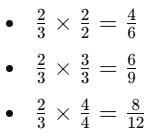
Thus, fractions like 4/6, 6/9, and 8/12 are equivalent to 2/3.

Thus, fractions like 4/6, 6/9, and 8/12 are equivalent to 2/3.
By how much is 9/18 greater than 4/18?- a)3/18
- b)21/18
- c)5/18
- d)13/18
Correct answer is option 'C'. Can you explain this answer?
By how much is 9/18 greater than 4/18?
a)
3/18
b)
21/18
c)
5/18
d)
13/18

|
Dr Manju Sen answered |
To find how much 9/18 is greater than 4/18, subtract 4/18 from 9/18:

So, 9/18 is 5/18 greater than 4/18.

So, 9/18 is 5/18 greater than 4/18.
Chapter doubts & questions for Common Fractions (Term 4) - Mathematics for Grade 6 2025 is part of Grade 6 exam preparation. The chapters have been prepared according to the Grade 6 exam syllabus. The Chapter doubts & questions, notes, tests & MCQs are made for Grade 6 2025 Exam. Find important definitions, questions, notes, meanings, examples, exercises, MCQs and online tests here.
Chapter doubts & questions of Common Fractions (Term 4) - Mathematics for Grade 6 in English & Hindi are available as part of Grade 6 exam.
Download more important topics, notes, lectures and mock test series for Grade 6 Exam by signing up for free.
Mathematics for Grade 6
423 docs|24 tests
|

Contact Support
Our team is online on weekdays between 10 AM - 7 PM
Typical reply within 3 hours
|
Free Exam Preparation
at your Fingertips!
Access Free Study Material - Test Series, Structured Courses, Free Videos & Study Notes and Prepare for Your Exam With Ease

 Join the 10M+ students on EduRev
Join the 10M+ students on EduRev
|

|
Create your account for free
OR
Forgot Password
OR
Signup to see your scores
go up within 7 days!
Access 1000+ FREE Docs, Videos and Tests
Takes less than 10 seconds to signup

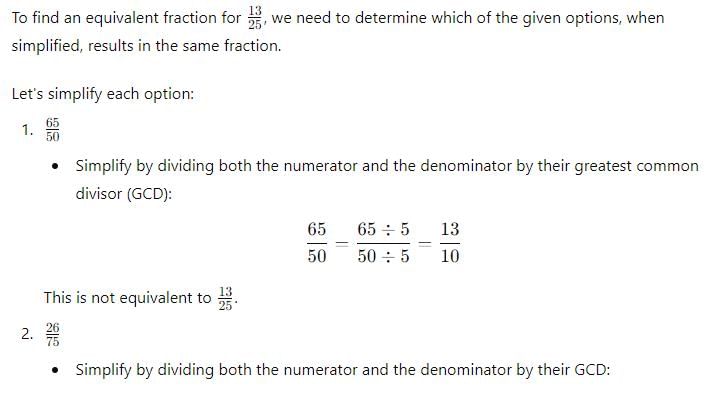
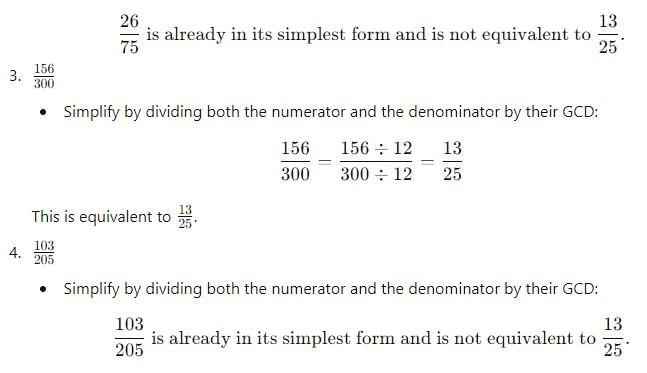



 is
is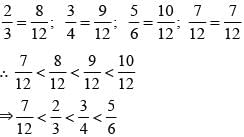






 to get 19?
to get 19?









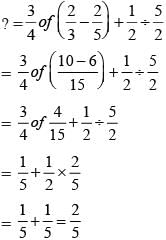




















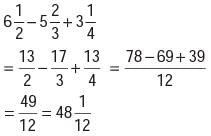
 m long broke into two pieces. One piece is 5/8 m long, then what is the length of other piece?
m long broke into two pieces. One piece is 5/8 m long, then what is the length of other piece? 












 to get
to get 










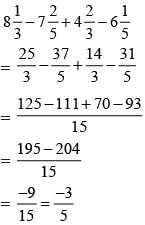
















 litres of milk. Out of this milk
litres of milk. Out of this milk  litres was consumed. How much milk is left with him?
litres was consumed. How much milk is left with him?




 is subtracted
is subtracted 












